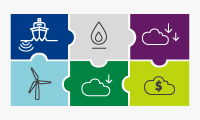Environmental performance
We improved or maintained our environmental performance across many business areas during 2017. This was due to operational improvements as well as reduced activities at some of our facilities and divestments. Details about our environmental performance are provided below and in the Greenhouse gas emissions, Managing methane emissions and Flaring sections.
Managing water use
In 2017, our intake of fresh water was 201 million cubic metres, about the same as 2016. Around 80% of our fresh water consumption was used for manufacturing oil products and chemicals, with the balance mainly consumed in oil and gas production. Around 40% of fresh-water intake was from public utilities such as municipal water supplies.
Fresh water withdrawn
million cubic metres
Enlarge imageFresh water consumed
million cubic metres
Enlarge imageSpills
Shell has clear requirements and procedures in place to prevent operational spills. We have routine programmes to maintain our facilities and pipelines, and improve their reliability, in order to reduce operational spills. However, spills still occur for reasons such as operational failure, accidents or unusual corrosion.
The volume of operational spills of oil and oil products in 2017 was 0.3 thousand tonnes, a decrease of around 60% from 2016. The number of operational spills increased to 99 from 72 in 2016. We have programmes in place to improve the long-term trend for the number of operational spills (See 10-year data table).
The number of spills caused by sabotage and theft increased to 62 from 49 in 2016. The volume of these spills decreased to 1.4 thousand tonnes in 2017 from 3.9 thousand tonnes in 2016. Sabotage and oil theft remained a significant cause of spills in the Niger Delta, Nigeria.
In 2017, we also recorded four spills of 0.3 thousand tonnes in total caused by the hurricane Harvey in the USA.
We investigate and learn from all spills to improve our performance and we clean up the areas around our operations that are affected by spills, irrespective of the cause. As of the end of March 2018, there were 3 spills under investigation in Nigeria that may result in adjustments to our figures.
Spills – operational [A]
Enlarge image[A] Over 100 kilograms.
Spills – sabotage [A]
Enlarge image[A] Sabotage and theft-related spills over 100 kilograms.
Energy efficiency
Improving the energy efficiency of the facilities we operate is one of the ways we manage our greenhouse gas (GHG) emissions. The main metric is energy intensity, the amount of energy consumed for every unit of output.
Shell-operated facilities and proposed projects that generate more than 50,000 tonnes of GHG emissions a year are required to produce a GHG and energy management plan with annual updates.
These plans must include the sources of GHG emissions, as well as a forecast of expected emissions at the site for at least 10 years, and must identify options for improving energy efficiency or reducing emissions.
Some of the ways Shell improved energy efficiency include making our equipment more reliable through regular maintenance, by smart scheduling of maintenance activities or by installing more energy-efficient equipment.
The overall energy intensity index of our chemical plants and refineries in 2017 was similar to the year before: our chemical plants improved to 88.2 in 2017, from 91.0 in 2016 and our refineries improved to 94.8 in 2017 from 95.4 in 2016.
Energy intensity – chemical plants
chemicals energy index [A]
Enlarge image[A] CEI calculation methodology changed in 2015; therefore, data for prior years are not directly comparable.
Energy intensity – refineries
refinery energy index [A]
Enlarge image[A] Indexed to 2002; based on 2006 Solomon EIITM methodology.
We aim to achieve superior energy-efficiency performance at our 17 operated refineries and chemicals plants and each site has a CO2 and energy-management plan. We invest in combined heat and power units and implement heat integration and waste gas recovery systems. We exchange steam turbine drives with electrical motors and replace end-of-life equipment with higher-efficiency types. We have incorporated top-quartile energy-efficiency technology into the design of our new-build chemicals plant in Pennsylvania, USA.
In 2017, the overall energy intensity for the production of oil and gas in our Upstream and Integrated Gas businesses (excluding liquefied natural gas and gas-to-liquids) increased slightly compared with 2016, mainly due to lower production from the NAM joint venture (Shell interest 50%) in the Netherlands. We expect it will be difficult to maintain the energy intensity levels of recent years, as existing fields age and new production comes from more energy-intensive sources. This may increase our upstream energy intensity over time.
Energy intensity – upstream
(excluding Oil Sands, GTL and LNG)
gigajoules/tonne production [A]
[A] 2012-2015 data are reported in accordance with IPIECA/API/OGP guidance 2010.
Other air emissions
We track emissions released into the atmosphere from our upstream and downstream facilities and work to reduce air pollution from our operations. This includes making investments to lower our emissions of nitrogen oxides, sulphur oxides and volatile organic compounds that are released during oil and gas production and processing. These pollutants can affect air quality in the areas where we operate. We evaluate and take action to mitigate potential adverse impacts of our emssions.
Our sulphur oxides emissions in 2017 remained relatively flat at 81 thousand tonnes compared with the previous year (83 thousand). A decrease in emissions due to divestment of Port Dickson refinery in Malaysia in 2016 was offset by higher emissions from the Bukom site in Singapore.
Our nitrogen oxides emissions decreased from 122 thousand tonnes in 2016 to 107 thousand tonnes in 2017. The decrease was mainly due to the change in oil sands mining reporting boundary and changes in calculation methodologies at some of our facilities (for example in Australia to align with regulatory methodologies).
Our emissions of volatile organic compounds (VOCs) decreased to 95 thousand tonnes in 2017 compared with 146 thousand tonnes in 2016. This was mostly due to a decrease of venting at our facilities in Majnoon, Iraq. We expect our VOC emissions to further decrease in the coming years as a result of our efforts to reduce flaring and venting.
 Sustainability at Shell
Sustainability at Shell
 Sustainable development goals
Sustainable development goals
 About our data
About our data
 Energy transition and climate change
Energy transition and climate change